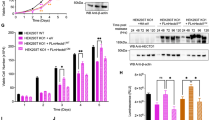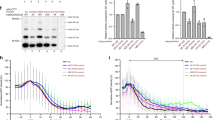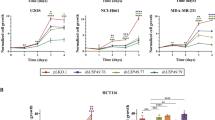Abstract
We recently described a novel checkpoint pathway that functions early in mitosis to delay chromosome condensation in response to microtubule poisons. The only gene implicated so far in this checkpoint pathway is chfr, whose protein product contains a RING domain and has ubiquitin ligase activity in vitro. The significance of this activity in vivo is unclear. A recent report suggested that the Chfr protein targets itself for proteasome-dependent degradation in mitotic cells through autoubiquitination. However, we observe that in mitosis Chfr exhibits a phosphorylation-dependent electrophoretic mobility shift with no change in overall protein levels. Further analysis of its ubiquitin ligase activity revealed that Chfr can catalyse the formation of noncanonical Lys63-linked polyubiquitin chains with Ubc13-Mms2 acting as the ubiquitin-conjugating enzyme. Ubc13-Mms2 and Lys63-polyubiquitin chains are not associated with targeting proteins to the proteasome, but rather with signaling cellular stress. We propose that Chfr may have a role in signaling the presence of mitotic stress induced by microtubule poisons.
This is a preview of subscription content, access via your institution
Access options
Subscribe to this journal
Receive 50 print issues and online access
$259.00 per year
only $5.18 per issue
Buy this article
- Purchase on Springer Link
- Instant access to full article PDF
Prices may be subject to local taxes which are calculated during checkout





Similar content being viewed by others
References
Brusky J, Zhu Y and Xiao W . (2000). Curr. Genet., 37, 168–174.
Chaturvedi P, Sudakin V, Bobiak ML, Fisher PW, Mattern MR, Jablonski SA, Hurle MR, Zhu Y, Yen TJ and Zhou BB . (2002). Cancer Res., 62, 1797–1801.
Ciechanover A, Orian A and Schwartz AL . (2000). Bioessays, 22, 442–451.
Corn PG, Summers MK, Fogt F, Virmani AK, Gazdar AF, Halazonetis TD and El-Deiry WS . (2003). Carcinogenesis, 24, 47–51.
Deng L, Wang C, Spencer E, Yang L, Braun A, You J, Slaughter C, Pickart C and Chen ZJ . (2000). Cell, 103, 351–361.
Durocher D, Henckel J, Fersht AR and Jackson SP . (1999). Mol. Cell, 4, 387–394.
Durocher D, Taylor IA, Sarbassova D, Haire LF, Westcott SL, Jackson SP, Smerdon SJ and Yaffe MB . (2000). Mol. Cell, 6, 1169–1182.
Fang S, Jensen JP, Ludwig RL, Vousden KH and Weissman AM . (2000). J. Biol. Chem., 275, 8945–8951.
Hofmann RM and Pickart CM . (1999). Cell, 96, 645–653.
Honda R, Tanaka H and Yasuda H . (1997). FEBS Lett., 420, 25–27.
Honda R and Yasuda H . (2000). Oncogene, 19, 1473–1476.
Joazeiro CA, Wing SS, Huang H, Leverson JD, Hunter T and Liu YC . (1999). Science, 286, 309–312.
Kang D, Chen J, Wong J and Fang G . (2002). J. Cell Biol., 156, 249–259.
Levkowitz G, Waterman H, Ettenberg SA, Katz M, Tsygankov AY, Alroy I, Lavi S, Iwai K, Reiss Y, Ciechanover A, Lipkowitz S and Yarden Y . (1999). Mol. Cell, 4, 1029–1040.
Liao H, Byeon IJ and Tsai MD . (1999). J. Mol. Biol., 294, 1041–1049.
Lorick KL, Jensen JP, Fang S, Ong AM, Hatakeyama S and Weissman AM . (1999). Proc. Natl. Acad. Sci. USA, 96, 11364–11369.
Mizuno K, Osada H, Konishi H, Tatematsu Y, Yatabe Y, Mitsudomi T, Fujii Y and Takahashi T . (2002). Oncogene, 21, 2328–2333.
Pickart CM . (2001). Mol. Cell, 8, 499–504.
Scolnick DM and Halazonetis TD . (2000). Nature, 406, 430–435.
Shibata Y, Haruki N, Kuwabara Y, Ishiguro H, Shinoda N, Sato A, Kimura M, Koyama H, Toyama T, Nishiwaki T, Kudo J, Terashita Y, Konishi S, Sugiura H and Fujii Y . (2002). Carcinogenesis, 23, 1695–1700.
Stavridi ES, Huyen Y, Loreto IR, Scolnick DM, Halazonetis TD, Pavletich NP and Jeffrey PD . (2002). Structure, 10, 891–899.
Torres-Ramos CA, Prakash S and Prakash L . (2002). Mol. Cell. Biol., 22, 2419–2426.
Ulrich HD and Jentsch S . (2000). EMBO J., 19, 3388–3397.
Wang C, Deng L, Hong M, Akkaraju GR, Inoue J and Chen ZJ . (2001). Nature, 412, 346–351.
Wang P, Byeon IJ, Liao H, Beebe KD, Yongkiettrakul S, Pei D and Tsai MD . (2000). J. Mol. Biol., 302, 927–940.
Xiao W, Chow BL, Broomfield S and Hanna M . (2000). Genetics, 155, 1633–1641.
Zheng N, Wang P, Jeffrey PD and Pavletich NP . (2000). Cell, 102, 533–539.
Acknowledgements
We thank Peter Howley for the gift of plasmids expressing wheat E1, UbcH7 and UbcH8 and Frank Rauscher III and Philip Leder for their support and helpful discussions. This study was supported in part by the National Cancer Institute Grant CA89630 (to TDH); JB and MS were supported by National Cancer Institute Training Grants CA09171 and CA09677, respectively.
Author information
Authors and Affiliations
Corresponding author
Rights and permissions
About this article
Cite this article
Bothos, J., Summers, M., Venere, M. et al. The Chfr mitotic checkpoint protein functions with Ubc13-Mms2 to form Lys63-linked polyubiquitin chains. Oncogene 22, 7101–7107 (2003). https://doi.org/10.1038/sj.onc.1206831
Received:
Revised:
Accepted:
Published:
Issue Date:
DOI: https://doi.org/10.1038/sj.onc.1206831
Keywords
This article is cited by
-
Systematic characterization of Brassica napus UBC13 genes involved in DNA-damage response and K63-linked polyubiquitination
BMC Plant Biology (2023)
-
Spatiotemporal regulation of the Dma1-mediated mitotic checkpoint coordinates mitosis with cytokinesis
Current Genetics (2019)
-
A Generic Platform for Cellular Screening Against Ubiquitin Ligases
Scientific Reports (2016)
-
Emerging evidence for CHFR as a cancer biomarker: from tumor biology to precision medicine
Cancer and Metastasis Reviews (2013)
-
Rice UBC13, a candidate housekeeping gene, is required for K63-linked polyubiquitination and tolerance to DNA damage
Rice (2012)



